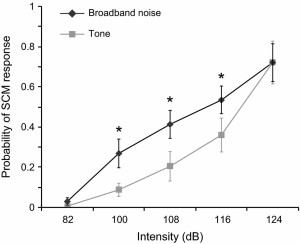In order to be able to confidently assert that any RT speeding following a startling acoustic stimulus (SAS) is the result of activation in subcortical areas related to the startle reflex, a reliable indication that a startle reflex actually occurred is required. While the eye-blink response is typically used to indicate a startle due to its consistency (Blumenthal et al., 2005), it may simply be too sensitive to loud acoustic stimuli to reliably predict sufficient activation of subcortical structures to elicit a StartReact response. Although higher intensity stimuli lead to a greater likelihood of observing a startle reflex (even once the blink response has saturated), it is prudent to consider limiting participant exposure to high intensity acoustic stimuli. One potential way to reduce the intensity while maintaining the probability of causing a startle reflex is to employ broadband white noise as the acoustic stimulus instead of a pure tone:
Abstract:
“A loud acoustic stimulus that elicits a startle reflex has long been used to study the neurophysiology of cortical and subcortical neural circuits. More recent investigations have shown that startle can act as an early trigger for prepared actions, suggesting a brainstem role in the preparation and initiation of actions. However, in order to attribute any startle-triggered voluntary responses to activation in subcortical structures it is necessary to measure a startle-related activity in these structures. The current study investigated the most effective stimulus for eliciting a detectible startle reflex. While more intense stimuli are more likely to elicit a startle reflex, the current study examined whether broadband noise is more likely than a pure tone to produce a startle at various intensities above 100dB. Participants performed a button release reaction time task in response to either a 1 kHz tone or a broadband noise pulse with intensities ranging from 82 to 124dB. Reaction time and EMG from the wrist extensors and the sternocleidomastoid (SCM) were measured. Results showed that startle-related SCM EMG was elicited more frequently by broadband noise compared to pure tones. The higher proportion of startle reflexes observed in SCM was associated with a higher incidence of the voluntary task being triggered early. A higher incidence of startle following broadband noise is attributed to the activation of a larger proportion of the basilar membrane; thus a lower intensity broadband noise stimulus may be used to elicit startle reflex at a similar rate as a higher intensity pure tone”
DOI: 10.14814/phy2.12509




